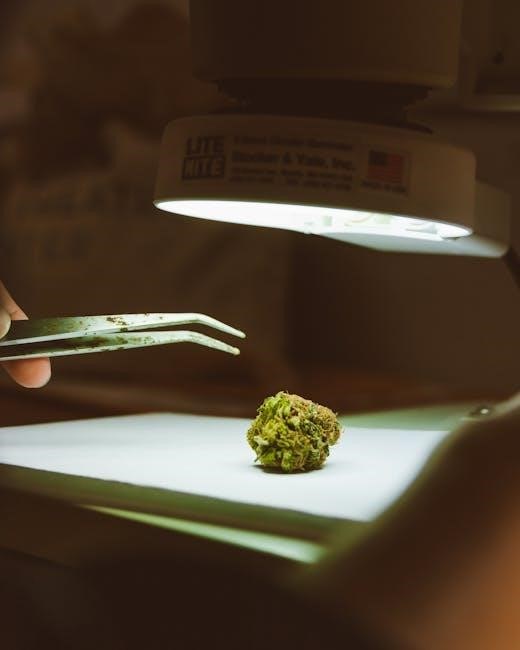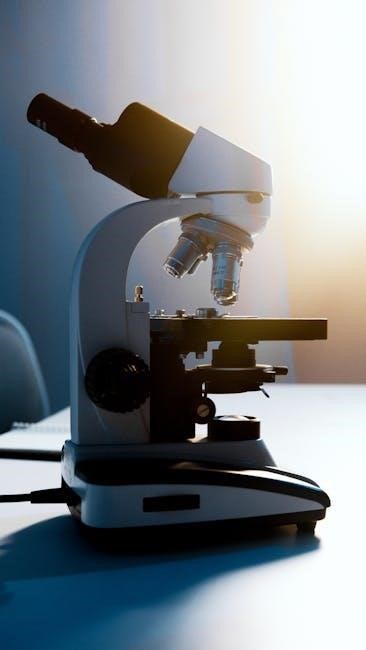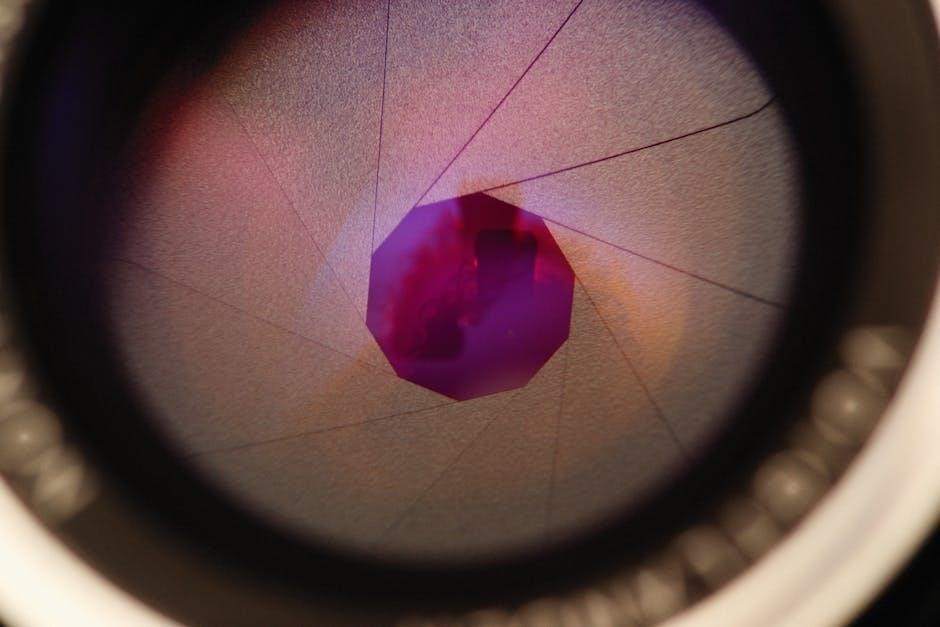A compound light microscope is a fundamental scientific tool used to magnify small objects, essential in biology, chemistry, and medical fields․ Its detailed parts and functions are often studied through educational worksheets, such as PDF guides, which provide labeled diagrams and interactive exercises to enhance understanding․ These resources help students grasp the microscope’s structure, operation, and significance in scientific exploration, making it an indispensable instrument in educational settings․
Overview of the Compound Light Microscope
The compound light microscope is a scientific instrument that uses two or more lenses to magnify specimens, making it essential for studying microscopic structures․ It consists of a light source, eyepiece, objective lenses, and a stage to hold specimens․ The microscope’s design allows for precise focus and magnification, enabling users to observe details invisible to the naked eye․ Educational resources, such as worksheets in PDF format, are widely used to teach students about its parts and functions․ These worksheets often include labeled diagrams, matching exercises, and descriptive questions to enhance learning․ The compound light microscope is a cornerstone in biology and chemistry education, helping students understand the microscopic world and its significance in scientific research․

Importance in Scientific Education
The compound light microscope plays a pivotal role in scientific education, particularly in biology and chemistry․ It allows students to explore the microscopic world, fostering curiosity and understanding of cellular structures and biological processes․ Worksheets and PDF guides are essential tools, providing interactive learning opportunities such as labeling parts, matching functions, and completing descriptive exercises․ These resources help students develop practical skills in microscopy and reinforce theoretical knowledge․ By incorporating hands-on activities, educators ensure that learners gain a comprehensive grasp of the microscope’s operation and its applications in scientific research․ This hands-on approach prepares students for advanced studies and careers in STEM fields, making the compound light microscope an indispensable educational resource․
Purpose of a Worksheet PDF
The primary purpose of a compound light microscope parts and functions worksheet PDF is to provide students with a structured and interactive learning tool․ These worksheets typically include labeled diagrams of the microscope, allowing students to identify and understand each component․ They also feature exercises such as matching parts to their functions, filling in the blanks, and short-answer questions․ This resource helps students review and reinforce their knowledge of the microscope’s structure and operation․ Additionally, worksheets often include practical activities, such as connecting parts to their descriptions using a ruler, which enhances engagement and retention․ Educators find these PDFs invaluable for classroom use, as they are easy to distribute, low-prep, and adaptable to various learning styles, making them an essential aid in science education․

Parts of the Compound Light Microscope
The compound light microscope consists of key components, including the eyepiece, objective lenses, stage, coarse and fine adjustment knobs, revolving nosepiece, diaphragm, light source, arm, base, stage clips, and body tube․

Eyepiece
The eyepiece, or ocular lens, is a crucial part of the compound light microscope․ It works in conjunction with the objective lenses to magnify specimens․ Typically, the eyepiece has a magnification power of 10x, though higher powers like 15x or 20x are also available․ Its primary function is to further enlarge the image produced by the objective lens, creating a detailed view of the sample․ The eyepiece is usually designed with a focus adjustment to accommodate individual vision differences, ensuring clear and sharp images․ In educational worksheets, identifying and understanding the eyepiece’s role is fundamental, as it directly impacts the microscope’s overall magnification capability․
Objective Lenses
Objective lenses are critical components of a compound light microscope, typically mounted on a revolving nosepiece․ They are available in various magnifications, such as low power (4x, 10x) and high power (40x, 100x)․ The objective lens collects light from the specimen and forms the first magnified image․ Its focal length determines the magnification power, with higher powers providing greater detail but a smaller field of view․ Proper alignment and focus of the objective lens are essential for clear observation․ Worksheets often include labeling exercises to help students identify and understand the role of objective lenses in microscopy, emphasizing their importance in achieving accurate magnification and image clarity in scientific studies;
Stage

The stage is a flat platform on the compound light microscope where specimens are placed for observation․ It is typically equipped with stage clips to securely hold slides in position, ensuring the specimen remains stationary during viewing․ The stage’s design allows for precise movement in both X and Y directions, enabling users to focus on different areas of the sample․ Worksheets often include diagrams of the stage, highlighting its role in specimen preparation and proper handling techniques․ Understanding the stage’s function is crucial for effective microscopy, as it directly impacts the quality of the image and the accuracy of observations in educational and laboratory settings․
Coarse Adjustment Knob
The coarse adjustment knob is a critical component of the compound light microscope, used to focus the specimen by moving the stage upward or downward․ This knob is typically located on the side of the microscope and is used in conjunction with the fine adjustment knob for precise focusing․ Worksheets often include labeled diagrams highlighting the coarse adjustment knob, explaining its role in the initial focusing process․ It is essential for bringing the specimen into rough focus before fine-tuning with the fine adjustment knob․ Proper use of the coarse adjustment knob ensures clear visibility of the sample, making it a fundamental part of microscope operation and a key topic in educational resources like the compound light microscope worksheet PDF․
Fine Adjustment Knob
The fine adjustment knob is a crucial part of the compound light microscope, used for making precise adjustments to focus the specimen․ Unlike the coarse adjustment knob, which moves the stage in larger increments, the fine adjustment knob allows for smaller, more exact movements․ Worksheets often detail its function, emphasizing its role in achieving sharp, clear images․ It is typically located near the coarse adjustment knob and works in tandem with it to ensure optimal focus․ Proper use of the fine adjustment knob is essential for high-resolution viewing, making it a key element in microscopy training and a common feature in educational materials like the compound light microscope worksheet PDF․
Revolving Nosepiece
The revolving nosepiece is a critical component of the compound light microscope, designed to hold multiple objective lenses of varying magnifications․ It allows users to switch between lenses effortlessly, maintaining focus on the specimen․ Worksheets often highlight its importance, as it enables quick transitions between low and high magnification without disturbing the slide․ The nosepiece rotates smoothly, ensuring that the selected objective lens aligns perfectly with the eyepiece․ This feature enhances efficiency in observation and is a key element in microscopy training; Understanding its function is essential for effective microscope operation, making it a common focus in educational resources like the compound light microscope worksheet PDF․

Diaphragm
The diaphragm is a crucial part of the compound light microscope, located below the stage․ Its primary function is to regulate the amount of light that enters the microscope․ By adjusting the diaphragm, users can control the intensity and focus of the light, ensuring optimal visibility of the specimen․ Worksheets often include activities that emphasize the diaphragm’s role in achieving proper illumination․ It typically consists of an aperture with different-sized holes, allowing for precise light adjustment․ Proper use of the diaphragm enhances image clarity and reduces glare, making it a fundamental aspect of microscopy training covered in educational resources like the compound light microscope worksheet PDF․
Light Source
The light source is a vital component of the compound light microscope, responsible for illuminating the specimen․ Typically, it is a built-in bulb, often LED or halogen, located at the base of the microscope․ The light source works in conjunction with the diaphragm and condenser to regulate the intensity and focus of the light․ Proper adjustment ensures clear visibility of the specimen under magnification․ Worksheets and educational resources, such as the compound light microscope worksheet PDF, often highlight the light source’s role in microscopy, emphasizing its importance for optimal image clarity and specimen observation․ Understanding its function is essential for effective microscope operation and is a key focus in student training materials․
Arm
The arm of a compound light microscope is a sturdy metal part that connects the microscope’s body tube to its base․ It provides structural support and stability, ensuring the instrument remains balanced and secure during use․ The arm allows for easy carrying and positioning of the microscope, making it portable for laboratory or classroom settings․ Educational resources, such as the compound light microscope worksheet PDF, often include diagrams highlighting the arm’s role in maintaining the microscope’s integrity․ Its durability is crucial for protecting the delicate optical components, ensuring long-term functionality and precise observations․ Understanding the arm’s purpose is fundamental for proper microscope handling and maintenance, as emphasized in various study materials․
Base
The base of a compound light microscope is the sturdy, flat structure that provides stability and support for the entire instrument․ Typically made of metal, it serves as the foundation, ensuring the microscope remains balanced and secure during use․ The base also houses the light source, which is essential for illuminating specimens․ Its solid construction prevents vibrations and movement, allowing for clear and precise observations․ Educational resources, such as the compound light microscope worksheet PDF, often highlight the base’s importance in maintaining the microscope’s functionality․ Understanding its role is crucial for proper handling and setup, as it directly impacts the quality of microscopic examinations․ The base’s design ensures durability and reliability, making it a critical component of the microscope’s overall performance․
Stage Clips
The stage clips are metal or plastic clamps located on the microscope stage, used to securely hold slides in place during observation․ They ensure the specimen remains stationary, preventing movement that could blur the image․ The clips are adjustable, allowing them to accommodate slides of varying thickness․ Properly securing the slide with the stage clips is essential for maintaining focus and achieving accurate results․ Educational worksheets, such as the compound light microscope worksheet PDF, often emphasize the importance of correctly using the stage clips․ Without them, the specimen may shift, making it difficult to obtain clear and precise observations․ Handling the stage clips with care is crucial to avoid damaging the microscope or the slides, ensuring reliable performance and extending the instrument’s lifespan․ Their role is vital in the overall functionality of the microscope․
Body Tube
The body tube is a critical component of the compound light microscope, connecting the eyepiece to the objective lenses․ It houses the optical system and maintains the proper distance between the eyepiece and objective lenses, ensuring precise alignment․ The body tube supports the microscope’s structural integrity and allows light from the objective lens to travel through to the eyepiece, enabling magnification․ Worksheets, such as the compound light microscope parts and functions PDF, often highlight the body tube’s role in maintaining image clarity․ Any misalignment or damage to the body tube can significantly affect the microscope’s performance, making it essential to handle with care․ Proper use and maintenance of the body tube are emphasized in educational materials to ensure optimal functionality and clear observations․ Its design contributes to the microscope’s ability to provide detailed views of specimens․ Regular cleaning and alignment checks are recommended to preserve its efficiency․ The body tube is a fundamental part of the microscope’s optical pathway, facilitating the transmission of light and images for accurate scientific study․ Understanding its function is vital for effective microscope operation, as outlined in educational resources and worksheets․ By ensuring the body tube is in good condition, users can achieve high-quality imaging and reliable results in various scientific applications․ The body tube’s durability and precise engineering make it an indispensable feature of the compound light microscope․ Its importance is consistently emphasized in educational materials, such as the compound light microscope worksheet PDF, to help students and researchers master microscope usage․

Functions of Each Part
Each component of the compound light microscope serves a specific role in achieving precise magnification and clear visualization of specimens․ The eyepiece magnifies the image formed by the objective lens, while the objective lenses focus light from the specimen, creating an image․ The stage holds the slide in place, and stage clips secure it, ensuring stability․ The coarse adjustment knob moves the stage up or down for initial focusing, and the fine adjustment knob refines the focus for clarity․ The revolving nosepiece allows switching between objective lenses, and the diaphragm regulates light intensity․ The light source illuminates the specimen, and the arm and base provide structural support․ Understanding these functions, as detailed in worksheets like the compound light microscope parts and functions PDF, is essential for effective microscope operation․ Proper use of each part ensures optimal performance and accurate observations, making these functions a cornerstone of microscopy education․ Regular practice with such resources helps users master the microscope’s capabilities, enabling them to conduct detailed scientific analyses efficiently․ The coordinated effort of each part highlights the microscope’s complexity and its importance in various fields․ Educational materials, including PDF worksheets, emphasize the necessity of recognizing and utilizing each part’s function to achieve successful microscopy outcomes․ By grasping these roles, users can fully exploit the microscope’s potential in their studies and research․ This comprehensive understanding fosters proficiency and confidence in handling the instrument, which is vital for advancing scientific knowledge․ The compound light microscope’s functionality relies on the seamless interaction of its parts, underscoring the importance of familiarity with each component’s role․ As outlined in educational resources, mastery of these functions is key to unlocking the microscope’s full capabilities, ensuring precise and reliable results in diverse applications․ Through dedicated study and practice, users can develop the skills needed to operate the microscope effectively, contributing to their success in scientific endeavors․ The compound light microscope remains an indispensable tool, and understanding its parts’ functions is the first step in harnessing its power for exploration and discovery․ Educational materials, such as the compound light microscope parts and functions worksheet PDF, play a crucial role in this learning process, providing structured guidance for students and researchers alike․ By focusing on each part’s function, these resources empower users to optimize their microscopy techniques and achieve their scientific goals․ The microscope’s design exemplifies precision engineering, with each part contributing to its overall functionality, making it an invaluable asset in laboratories and classrooms worldwide․ As scientific education evolves, the compound light microscope continues to be a cornerstone, and understanding its functions remains essential for future advancements․ The detailed breakdown of each part’s role in educational worksheets ensures that users can appreciate the microscope’s complexity and utilize it effectively․ This knowledge not only enhances technical skills but also deepens the appreciation for the intricate design behind this fundamental scientific instrument․ By mastering the functions of each part, individuals can unlock the full potential of the compound light microscope, driving progress in various fields of study․ The integration of theoretical knowledge with practical application, as facilitated by educational resources, is vital for proficiency in microscopy․ As such, the compound light microscope parts and functions worksheet PDF remains an essential tool for both learners and professionals, providing a comprehensive foundation for successful microscopy․ The microscope’s functionality is a testament to human innovation, and its continued use in education and research ensures its lasting impact on scientific discovery․ By understanding and respecting each part’s role, users can maintain and utilize the microscope effectively, contributing to a legacy of exploration and advancement․ The compound light microscope’s enduring relevance highlights the importance of education in microscopy, emphasizing the need for resources like the parts and functions worksheet PDF to guide future scientists․ Through continuous learning and practice, the microscope will remain a powerful tool, enabling groundbreaking discoveries and fostering a deeper understanding of the microscopic world․ The compound light microscope’s intricate design and precise functionality make it an indispensable instrument in scientific exploration, and its study is a cornerstone of educational curricula․ As technology advances, the principles learned through the microscope will continue to shape the scientific landscape, inspiring future generations to explore and innovate․ The compound light microscope parts and functions worksheet PDF serves as a foundational resource, equipping users with the knowledge needed to navigate the complexities of microscopy and contribute meaningfully to their fields․ By prioritizing education and mastery of each part’s function, individuals can harness the microscope’s capabilities, driving progress and expanding human knowledge․ The microscope’s legacy is a reminder of the power of education and innovation, and its continued use ensures that it will remain a vital tool in the pursuit of scientific excellence․ Through dedicated study and the use of educational resources, the compound light microscope will continue to unlock the secrets of the microscopic world, inspiring awe and curiosity in all who use it․ The compound light microscope’s impact on science is immeasurable, and its study through structured resources like the parts and functions worksheet PDF ensures its relevance for generations to come․ By embracing this knowledge, individuals can contribute to a brighter, more informed future, where the microscope remains a symbol of human ingenuity and the quest for understanding․ The compound light microscope’s enduring significance underscores the importance of educational resources in nurturing scientific literacy and fostering a deeper appreciation for the tools that shape our understanding of the world․ As we move forward, the microscope will continue to be a testament to the power of education and innovation, guiding us toward new discoveries and advancements․ The compound light microscope parts and functions worksheet PDF stands as a vital educational tool, helping to illuminate the path for future scientists and researchers․ By mastering the microscope’s intricacies, individuals can unlock new possibilities, contributing to a world driven by curiosity and a passion for learning․ The microscope’s legacy is a powerful reminder of the importance of education in shaping the future, and its continued presence in classrooms and laboratories ensures that it will remain a cornerstone of scientific exploration․ Through the compound light microscope parts and functions worksheet PDF, learners gain the foundation needed to explore the microscopic world with confidence and precision, paving the way for a lifetime of discovery and innovation․ The microscope’s impact on education and research is unparalleled, and its study through comprehensive resources ensures its continued relevance in an ever-evolving scientific landscape․ By prioritizing the understanding of each part’s function, users can fully appreciate the microscope’s design and potential, enabling them to make meaningful contributions to their fields․ The compound light microscope remains an essential instrument, and its study through educational resources like the parts and functions worksheet PDF is vital for the advancement of scientific knowledge․ As we continue to explore the microscopic world, the microscope stands as a powerful tool, inspiring wonder and driving discovery․ Through educational resources and dedicated practice, the compound light microscope will remain a cornerstone of scientific education, empowering individuals to achieve great things in their pursuit of knowledge․ The compound light microscope’s functionality is a testament to human ingenuity, and its continued use in education ensures that it will remain a vital instrument in the scientific community․ By understanding and mastering each part’s role, users can unlock the microscope’s full potential, contributing to a brighter future filled with discovery and innovation․ The compound light microscope parts and functions worksheet PDF serves as a key resource in this journey, providing the knowledge and skills needed to excel in microscopy․ As we look to the future, the microscope will continue to play a central role in scientific exploration, and its study through educational resources will remain essential for preparing the next generation of scientists and researchers․ The compound light microscope’s impact on education and research is immeasurable, and its continued presence in classrooms and laboratories ensures its lasting legacy as a tool for discovery and advancement․ By embracing the knowledge provided by resources like the parts and functions worksheet PDF, individuals can harness the microscope’s power, driving progress and expanding our understanding of the world․ The compound light microscope’s intricate design and precise functionality make it an indispensable instrument in scientific exploration, and its study is a cornerstone of educational curricula․ As technology advances, the principles learned through the microscope will continue to shape the scientific landscape, inspiring future generations to explore and innovate․ The compound light microscope parts and functions worksheet PDF serves as a foundational resource, equipping users with the knowledge needed to navigate the complexities of microscopy and contribute meaningfully to their fields․ By prioritizing education and mastery of each part’s function, individuals can harness the microscope’s capabilities, driving progress and expanding human knowledge․ The microscope’s legacy is a reminder of the power of education and innovation, and its continued use ensures that it will remain a vital tool in the pursuit of scientific excellence․ Through dedicated study and the use of educational resources, the compound light microscope will continue to unlock the secrets of the microscopic world, inspiring awe and curiosity in all who use it․ The compound light microscope’s impact on science is immeasurable, and its study through structured resources like the parts and functions worksheet PDF ensures its relevance for generations to come․ By embracing this knowledge, individuals can contribute to a brighter, more informed future, where the microscope remains a symbol of human ingenuity and the quest for understanding․ The compound light microscope’s enduring significance underscores the importance of educational resources in nurturing scientific literacy and fostering a deeper appreciation for the tools that shape our understanding of the world․ As we move forward, the microscope will continue to be a testament to the power of education and innovation, guiding us toward new discoveries and advancements․ The compound light microscope parts and functions worksheet PDF stands as a vital educational tool, helping to illuminate the path for future scientists and researchers․ By mastering the microscope’s intricacies, individuals can unlock new possibilities, contributing to a world driven by curiosity and a passion for learning․ The microscope’s legacy is a powerful reminder of the importance of education in shaping the future, and its continued presence in classrooms and laboratories ensures that it will remain a cornerstone of scientific exploration․ Through the compound light microscope parts and functions worksheet PDF, learners gain the foundation needed to explore the microscopic world with confidence and precision, paving the way for a lifetime of discovery and innovation․ The microscope’s impact on education and research is unparalleled, and its study through comprehensive resources ensures its continued relevance in an ever-evolving scientific landscape․ By prioritizing the understanding of each part’s function, users can fully appreciate the microscope’s design and potential, enabling them to make meaningful contributions

How the Compound Light Microscope Works
The compound light microscope works by using eyepiece and objective lenses to magnify objects, with light illuminating the specimen․ Adjustment knobs focus the image for clarity․
Role of Lenses in Magnification
The compound light microscope relies on two primary lenses for magnification: the eyepiece and the objective lens․ The objective lens, positioned near the specimen, creates an initial magnified image․ The eyepiece then enlarges this image further, significantly increasing the overall magnification power; This dual-lens system allows for higher resolution and clearer observation of microscopic structures․ The combination of these lenses ensures that light from the specimen is focused and amplified, enabling detailed examination․ Proper alignment and adjustment of these lenses are crucial for achieving sharp, distortion-free images, making them essential components in both educational and professional microscopy applications․
Importance of Light in Microscopy
Light plays a crucial role in microscopy as it illuminates the specimen, enabling visualization of its structural details․ In a compound light microscope, the light source provides the necessary illumination to produce a clear image․ Proper adjustment of light intensity, often controlled by the diaphragm, ensures optimal brightness and contrast․ The quality of light directly affects image resolution and clarity, making it essential for accurate observations․ Without sufficient light, specimens would appear dim or indistinct, hindering detailed analysis․ Thus, light is fundamental to the functionality of a microscope, facilitating scientific exploration and education by revealing the microscopic world with precision and clarity․
Process of Achieving Focus
Achieving focus in a compound light microscope involves a systematic approach to ensure clear specimen visualization․ Begin by placing the prepared slide on the stage, securing it with stage clips․ Using the coarse adjustment knob, lower the objective lens until it nearly touches the slide․ Next, switch to the fine adjustment knob to bring the specimen into sharp focus․ Start with a low-power objective lens for initial focusing, then switch to higher magnification for detailed observation․ Proper illumination, adjusted via the diaphragm, enhances clarity․ Ensuring the specimen is centered and evenly lit is crucial for optimal focus․ This step-by-step process is essential for obtaining precise and detailed microscopic images, making it a fundamental skill in microscopy․
Understanding Magnification Power
Magnification power in a compound light microscope is the ability to enlarge specimens for detailed observation․ It is calculated by multiplying the power of the eyepiece lens by the power of the objective lens; Common combinations include 10x eyepiece with 40x or 100x objectives, resulting in 400x or 1000x magnification․ The microscope’s total magnification determines the level of detail visible․ Higher magnification reveals smaller structures but may reduce the field of view․ Proper focus and illumination are critical to maximize clarity at higher powers․ Understanding magnification power is essential for effectively using the microscope to study specimens at varying scales, ensuring accurate observations in scientific and educational settings․
Tips for Using the Compound Light Microscope
Always handle the microscope gently, using both hands to support it․ Clean lenses with soft cloth and avoid touching them․ Prepare slides carefully, focus slowly, and adjust illumination properly for clear observations․
Preparing the Microscope for Use
To prepare the compound light microscope, ensure it is placed on a stable, flat surface․ Plug in the light source and turn it on to test illumination․ Clean all lenses with a soft, dry cloth to prevent dust interference․ Adjust the stage clips to secure the slide properly, ensuring the specimen is centered․ Set the revolving nosepiece to the low-power objective lens․ Use the coarse adjustment knob to lower the stage until the specimen is near the lens․ Fine-tune the focus using the fine adjustment knob for clarity․ Always handle the microscope with care to maintain its precision and longevity․ Proper preparation ensures optimal performance and clear observations․

Proper Handling Techniques
Proper handling of the compound light microscope is essential to maintain its functionality and longevity․ Always carry the microscope with two hands, supporting the base and arm to prevent accidental drops․ Avoid touching the lenses to prevent smudging; use lens paper for cleaning․ When handling slides, ensure they are securely placed under the stage clips to avoid damage․ Never force the focus knobs, as this can misalign the lenses․ After use, turn off the light source and store the microscope in a dry, protective case․ Regular cleaning and proper storage prevent wear and tear, ensuring the microscope remains in optimal condition for future use․

Maintaining the Microscope
Regular maintenance is crucial to ensure the compound light microscope remains in optimal working condition․ Clean the lenses with soft, lint-free lens paper to prevent dust and smudges from interfering with image clarity․ Check the light source regularly and replace it if it shows signs of wear․ Lubricate moving parts, such as the coarse and fine adjustment knobs, to ensure smooth operation․ Store the microscope in a protective case or cover when not in use to shield it from dust and accidental damage․ Avoid using harsh chemicals or abrasive materials, as they may damage the microscope’s components․ Always follow the manufacturer’s guidelines for cleaning and maintenance to extend the lifespan of the instrument․
